When is afterload low - Study guides, Class notes & Summaries
Looking for the best study guides, study notes and summaries about When is afterload low? On this page you'll find 2107 study documents about When is afterload low.
Page 4 out of 2.107 results
Sort by

-
CEN Study Guide Exam With 100% Correct Answers
- Exam (elaborations) • 39 pages • 2024
- Available in package deal
-
- $11.08
- + learn more
CEN Study Guide Exam With 100% Correct Answers When is Afterload low? Correct Answer: Only in Distributive Shock Preload volume is measured by? Correct Answer: CVP (Right Atrial pressure) Afterload volume is measured by? Correct Answer: SVR (Systemic vascular resistance What increases preload? Correct Answer: Volume (Fluids) What decreases preload? Correct Answer: Diuretics/NTG What decreases afterload? Correct Answer: NTG/Nipride What increased afterload? Correct Answer: ...

-
PCCN EXAM Questions With 100% Verified Answers Latest Update 2024/2025 (GRADED)
- Exam (elaborations) • 50 pages • 2024
-
- $17.49
- + learn more
PCCN EXAM Questions With 100% Verified Answers Latest Update 2024/2025 (GRADED) Coronary artery perfusion is dependent upon: A. diastolic pressure B. systolic pressure C. afterload D. systemic vascular resistance (SVR) A. diastolic pressure Diastolic pressure in the aortic root is higher than left ventricular end-diastolic pressure (LVEDP), the pressure exerted on the ventricular muscle at the end of diastole when the ventricle is full. This enables blood to flow from a higher pressure ...
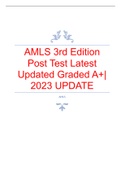
-
AMLS 3rd Edition Post Test Latest Updated Graded A+| 2023 UPDATE
- Exam (elaborations) • 7 pages • 2023
-
- $15.99
- 1x sold
- + learn more
AMLS 3rd Edition Post Test Latest Updated Graded A+| 2023 UPDATEAMLS 3rd Edition Post Test Latest Updated Graded A+ Which of the following may cause primary respiratory alkalosis? A. Fever B. Chest Wall Pain C. Vomiting D. Renal Failure - ANSWERA. Fever A quadriplegic male is experiencing difficulty breathing and restlessness. His skin is flush and his urine is dark yellow and cloudy. Vital signs are BP 86/68, P 128, R 24, temp is 38 C. Which type of shock should you suspect? A. Hypov...
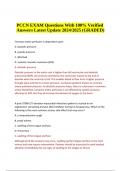
-
PCCN EXAM Questions With 100% Verified Answers Latest Update 2024/2025 (GRADED)
- Exam (elaborations) • 50 pages • 2024
-
- $16.49
- + learn more
PCCN EXAM Questions With 100% Verified Answers Latest Update 2024/2025 (GRADED) Coronary artery perfusion is dependent upon: A. diastolic pressure B. systolic pressure C. afterload D. systemic vascular resistance (SVR) A. diastolic pressure Diastolic pressure in the aortic root is higher than left ventricular end-diastolic pressure (LVEDP), the pressure exerted on the ventricular muscle at the end of diastole when the ventricle is full. This enables blood to flow from a higher pressure ...
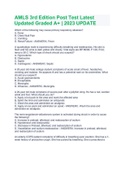
-
AMLS 3rd Edition Post Test Latest Updated Graded A+ | 2023 UPDATE .
- Exam (elaborations) • 6 pages • 2023
- Available in package deal
-
- $9.99
- 1x sold
- + learn more
AMLS 3rd Edition Post Test Latest Updated Graded A+ | 2023 UPDATE . Which of the following may cause primary respiratory alkalosis? A. Fever B. Chest Wall Pain C. Vomiting D. Renal Failure - ANSWERA. Fever A quadriplegic male is experiencing difficulty breathing and restlessness. His skin is flush and his urine is dark yellow and cloudy. Vital signs are BP 86/68, P 128, R 24, temp is 38 C. Which type of shock should you suspect? A. Hypovolemic B. Obstructive C. Septic D. Cardiogenic ...

-
UNDERSTANDING PHARMACOLOGY FOR ESSENTIALS MEDICATION SAFETY CHAPTER 1-28 TESTBANK BY WORKMAN & LACHARITY
- Exam (elaborations) • 690 pages • 2024
- Available in package deal
-
- $28.99
- + learn more
UNDERSTANDING PHARMACOLOGY FOR ESSENTIALS MEDICATION SAFETY CHAPTER 1-28 TESTBANK BY WORKMAN & LACHARITY Chapter 1: Drug Therapy for Heart Failure MULTIPLE CHOICE BASIC CONCEPTS 1. What does the term “afterload” mean? a. The amount of blood entering the left ventricle that must be pumped out of the heart b . The peripheral resistance of the arterial system, including mean arterial pressure c. The ability of the living muscle fibers of the heart to contract and pump blood d . The p...
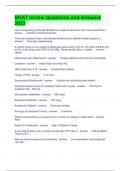
-
BKAT review Questions and Answers 2023
- Exam (elaborations) • 4 pages • 2023
- Available in package deal
-
- $20.99
- 1x sold
- + learn more
BKAT review Questions and Answers 2023 Upon recognizing ventricular fibrillation in a safe environment, the nurse should then establish unresponsiveness The most important step in preventing central venous catheter related sepsis is: Thorough handwashing. A routine check of your patient's blood gas values show a pH of 7.40, pO2 of 98mm Hg, pCO2 of 38 mmhg, and HCO3 of 25 mEq. These results reflect Normal values Nitropressin and Dobutamine Reduce afterload and improve c...
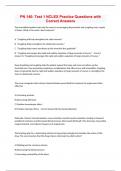
-
PN 140: Test 1 NCLEX Practice Questions with Correct Answers
- Exam (elaborations) • 26 pages • 2024
- Available in package deal
-
- $10.99
- + learn more
PN 140: Test 1 NCLEX Practice Questions with Correct Answers The immobilized patient asks why the nurse is encouraging deep breaths and coughing every couple of hours. What is the nurse's best response? A. "Coughing will help strengthen the chest muscles." B. "Coughing helps strengthen the abdominal muscles." C. "Coughing helps move secretions up the bronchial tree gradually." D. "Coughing encourages the rapid and sudden expulsion of large amounts of mucus." - Correct Answer D. ...
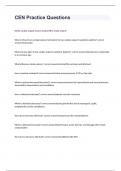
-
CEN Practice Questions with 100% correct answers
- Exam (elaborations) • 18 pages • 2024
-
- $16.49
- + learn more
Define cardiac output correct answersHR x stroke volume What is the primary compensatory mechanism for low cardiac output in pediatric patients? correct answersTachycardia What are late signs of low cardiac output in pediatric patients? correct answersHypotension, bradycardia is an ominous sign What influences stroke volume? correct answersContractility, preload, and afterload How is preload evaluated? correct answersCentral venous pressure (CVP) on the right When is preload incre...
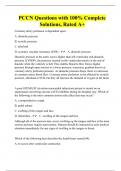
-
PCCN Questions with 100% Complete Solutions, Rated A+
- Exam (elaborations) • 90 pages • 2024
- Available in package deal
-
- $13.99
- + learn more
Coronary artery perfusion is dependent upon: A. diastolic pressure B. systolic pressure C. afterload D. systemic vascular resistance (SVR) - A. diastolic pressure Diastolic pressure in the aortic root is higher than left ventricular end-diastolic pressure (LVEDP), the pressure exerted on the ventricular muscle at the end of diastole when the ventricle is full. This enables blood to flow from a higher pressure through open arteries to a lower pressure, a pressure gradient known as coronar...

That summary you just bought made someone very happy. Also get paid weekly? Sell your study resources on Stuvia! Discover all about earning on Stuvia


